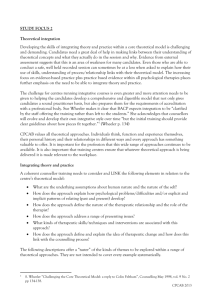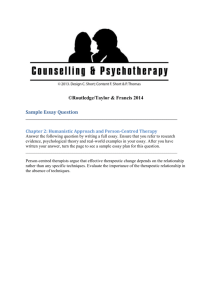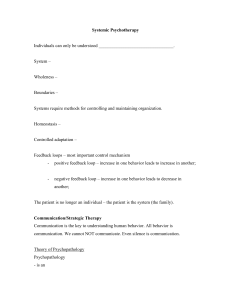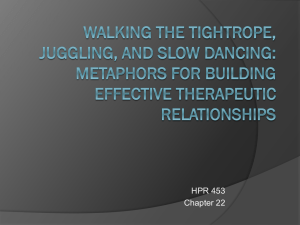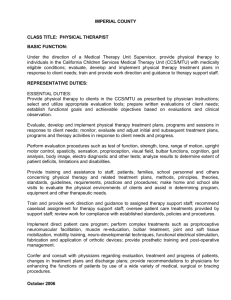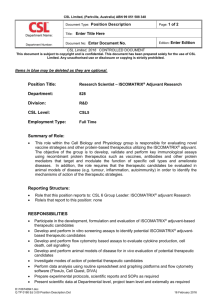Study Focus #3: theoretical integration within the training
advertisement
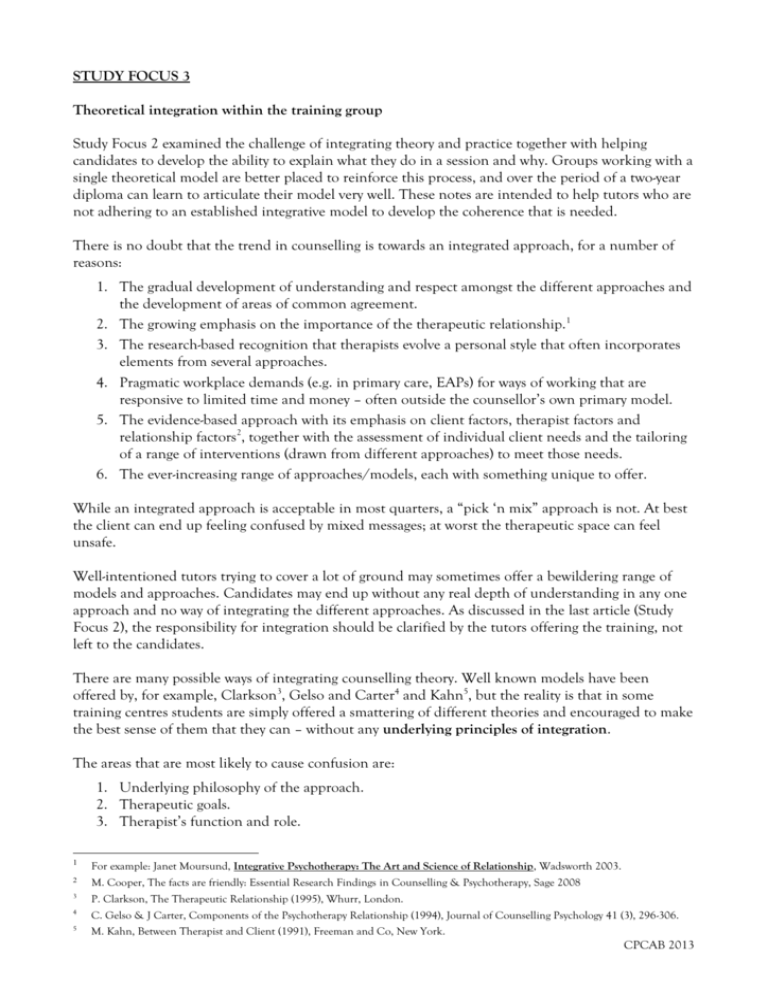
STUDY FOCUS 3 Theoretical integration within the training group Study Focus 2 examined the challenge of integrating theory and practice together with helping candidates to develop the ability to explain what they do in a session and why. Groups working with a single theoretical model are better placed to reinforce this process, and over the period of a two-year diploma can learn to articulate their model very well. These notes are intended to help tutors who are not adhering to an established integrative model to develop the coherence that is needed. There is no doubt that the trend in counselling is towards an integrated approach, for a number of reasons: 1. The gradual development of understanding and respect amongst the different approaches and the development of areas of common agreement. 2. The growing emphasis on the importance of the therapeutic relationship.1 3. The research-based recognition that therapists evolve a personal style that often incorporates elements from several approaches. 4. Pragmatic workplace demands (e.g. in primary care, EAPs) for ways of working that are responsive to limited time and money – often outside the counsellor’s own primary model. 5. The evidence-based approach with its emphasis on client factors, therapist factors and relationship factors2, together with the assessment of individual client needs and the tailoring of a range of interventions (drawn from different approaches) to meet those needs. 6. The ever-increasing range of approaches/models, each with something unique to offer. While an integrated approach is acceptable in most quarters, a “pick ‘n mix” approach is not. At best the client can end up feeling confused by mixed messages; at worst the therapeutic space can feel unsafe. Well-intentioned tutors trying to cover a lot of ground may sometimes offer a bewildering range of models and approaches. Candidates may end up without any real depth of understanding in any one approach and no way of integrating the different approaches. As discussed in the last article (Study Focus 2), the responsibility for integration should be clarified by the tutors offering the training, not left to the candidates. There are many possible ways of integrating counselling theory. Well known models have been offered by, for example, Clarkson3, Gelso and Carter4 and Kahn5, but the reality is that in some training centres students are simply offered a smattering of different theories and encouraged to make the best sense of them that they can – without any underlying principles of integration. The areas that are most likely to cause confusion are: 1. Underlying philosophy of the approach. 2. Therapeutic goals. 3. Therapist’s function and role. 1 For example: Janet Moursund, Integrative Psychotherapy: The Art and Science of Relationship, Wadsworth 2003. 2 M. Cooper, The facts are friendly: Essential Research Findings in Counselling & Psychotherapy, Sage 2008 3 P. Clarkson, The Therapeutic Relationship (1995), Whurr, London. 4 C. Gelso & J Carter, Components of the Psychotherapy Relationship (1994), Journal of Counselling Psychology 41 (3), 296-306. 5 M. Kahn, Between Therapist and Client (1991), Freeman and Co, New York. CPCAB 2013 Here is a simplified comparison of some key approaches: Approach Basic philosophy Goals of therapy Therapeutic relationship Person-centred All humans have the capacity for growth and change given the right conditions. To move towards organismic self with greater trust in self, ability to be more spontaneous and alive. Quality of relationship is paramount, with emphasis on creating the core conditions to enable client to accept self. Psychodynamic The self is a dynamic intrapersonal field shaped by early relationships that unconsciously drive present ones. Making early developmental relationships explicit, together with working with a client’s defences against overwhelming unconscious pain, are seen as central to the therapeutic process. To make the unconscious conscious and thus be free to choose rather than be driven by past unconscious choices. This is, however, viewed as a very hard and lengthy process that necessarily involves a journey into the heart’s most painful regions. Working with the unconscious clientcounsellor relationship, the counsellor both ‘holds back’ in a deep listening mode and ‘holds on’ when the client’s pain is projected out onto him/her. Sometimes s/he offers interpretations to help make unconscious processes more conscious. Gestalt Rooted in existential philosophy and phenomenology. Holistic and anti-deterministic. To work towards greater awareness and choice by immediate experiencing of “what is” in the present, to enable greater responsibility and self support. Working with the “Now” to bring things into immediate awareness. Counsellor active in setting up dialogue between parts of self and to work on “unfinished business”. Often very challenging. Transactional analysis Humans capable of making new decisions and everybody has choices. To help clients become free of old “scripts” and make new decisions. To make the “games” we play explicit in order to change them. Collaborative equal relationship with clear goals established for specific changes. Cognitive behavioural Humans born capable of rational thinking but develop irrational beliefs that influence behaviour and emotional responses. To develop more realistic beliefs and eliminate maladaptive behaviour. More like teacher-student (or coaching) relationship, with the counsellor challenging irrational beliefs and helping client to identify realistic goals and expectations of self. Existential Focus on the nature of being human and the striving towards meaning, authenticity and relationship in the face of the “givens” of life e.g. death or meaninglessness. To identify blocks to freedom and authenticity. To challenge self to be selfdetermining and responsible for own life. Emphasis on the authentic encounter of two unique individuals through which the client can discover his own uniqueness and meaning. (contemporary relational approach rather than classical Freudian) CPCAB 2013 Candidates need to be aware of the fundamental contradictions and tensions that arise between different philosophies, theoretical ideas and the associated skills when trying to integrate theory. For example: 1. Freud’s ideas about powerful unconscious drives and the instinct to repress do not sit easily with existential ideas of freewill or humanistic ideas of continual growth. 2. The psychodynamic focus on past and early development does not sit easily with the Gestalt injunction to be in the present or the humanistic notion of being in the “here and now”. 3. Cognitive behavioural methods of challenging irrational beliefs fundamentally contradict the cornerstone of the person-centred approach that sessions are client-led. 4. It simply doesn’t make sense to believe in the philosophy that the client has the capacity to find their own answers (a person-centred principle) and then ask leading questions, suggest a course of action or set homework in the session. One of the most common mistakes is lack of awareness that these contradictions are present. For example candidates in external assessment make comments like this: “My approach is mainly person-centred…. I apply the core conditions. In this session, however I thought the cognitive approach would be helpful and I challenged my client’s belief that everything she touches goes wrong ….” Even more worrying are comments like: “My client was talking about the past so I thought I would use the psychodynamic approach …” The Triangle of Insight “In Here” relationship with the therapist in the here and now. How are the clients difficulties present in the room? What skills and attitudes does the therapist need to facilitate change? “Out There” relationships with others, current or recent past, usually related to the presenting issue. What are the client’s current difficulties and how would this theoretical approach describe them in terms of their patterns of relating? Where is the focus of the work likely to be (in here, out there, or back then)? What would change (process) look like in this approach? “Back Then” relationships with past significant others. What concepts does this approach use to explain how the self is structured and how this relates to early development? What helps me understand my own history? CPCAB 2013 There are different principles for integration. The philosophy might be the integrating principle, hence the many “humanistic” courses. But even within these courses tensions must be addressed: in each course care needs to be taken to address the contradictions, so as to provide a coherent model. As mentioned above, the therapeutic relationship is increasingly seen as the focus for integration, with growing research data supporting the notion that the quality of the relationship is the determining factor in therapeutic change. Kahn (see previous reference) has produced a key work on the relationship, with an artful synthesis of psychodynamic and humanistic ideas – integrating Freud, Rogers, Gill and Kohut. Another useful model which can help candidates to develop the ability to integrate theory based on the therapeutic relationship, but without presenting them with a fixed model of integration, is the “Triangle of Insight” developed by Karl Menninger6. Although this is a psychodynamic concept it can be used as a template on which to “map” different theoretical approaches: most counselling theories can be mapped onto this triangle. This framework can help trainees anchor and compare approaches and explore the differences while finding and developing their own style. This promotes difference and diversity within training groups without leaving trainees to either flounder or to adhere to a fixed model. The CPCAB’s model of three therapeutic methods – working with the structure of the self, with personal history and with patterns of relating (both ‘in here’ and ‘out there‘) – also provides a basis for an integrative framework for a broad range of theoretical approaches. Each approach has a different emphasis with different skills and, more importantly, a different understanding of the therapeutic process and its associated therapeutic goals. Courses need therefore to carefully think through how this model can be used to help candidates develop a coherent framework for describing what they do, how the client came to be the way he/she is, what would constitute change, and how the therapist facilitates change in the relationship. It can also be helpful in making the link with what makes sense to them personally: 1. What theory helps explain their understanding of themselves, their development and their past patterns of relating? 2. How are these patterns still present in their current relationships/difficulties? 3. How are these patterns present, or likely to be present, in the therapeutic relationship? In their client-work they can also examine how they shift between: A focus on the present shape of the client’s internal world (the structure of the self) and how working, for example, through a dialogue between parts of the self, the associated internal conflicts can be resolved or reduced. A focus on how the self became the shape it is and how, by working to re-interpret and cope (differently) with past traumas, that shape, and those internal conflicts, can also change for the better. A focus on the patterns of the client’s relationships (‘in here’ in the client-counsellor relationship and ‘out there’ in present/recent close relationships) and how working directly on those relationships can also help to change both the client’s inner world and the relationships themselves. If each theory in an integrative course is introduced within this CPCAB framework of three therapeutic methods, it allows for individual candidates to develop individual approaches within a common framework. 6 The Theory of Psychoanalytic Technique, 1958. CPCAB 2013 During the second year (of the CPCAB counselling diploma), candidates need to be challenged to focus on, work with and develop an individual style and emphasis based on one (and certainly no more than two theoretical models). The need to focus and explore a limited number of theories more deeply can be encouraged by a building block approach where the candidate’s understanding and application of their approach is developed in a structured way, for example: 1. Individual assignments on a chosen theory to encourage wider reading and understanding of one approach and underlying philosophy and concepts regarding self, personal history and patterns of relating. 2. Application of these ideas to own self, history and patterns of relating in personal journal work. 3. Focus on skills by analysis of counselling practice sessions e.g. via audio/video recording session, transcripts with focus on skills and attitudes compatible with this approach. 4. Case study on work with one client (in placement), focusing on process and use of supervision within this approach, with reference to client’s self, personal history and patterns of relating. 5. Written assignment describing integration of understanding of this approach with reference to themselves and their work with several clients. In conclusion, tutors on integrative courses that are not adhering to an established integrative model need to be very clear about the framework for integration that they are utilising. That framework needs to be embodied in the course not just via the course manual, but also across the range of sessions themselves and within the tutor’s feedback on the candidates’ skills and their full range of coursework. CPCAB 2013
